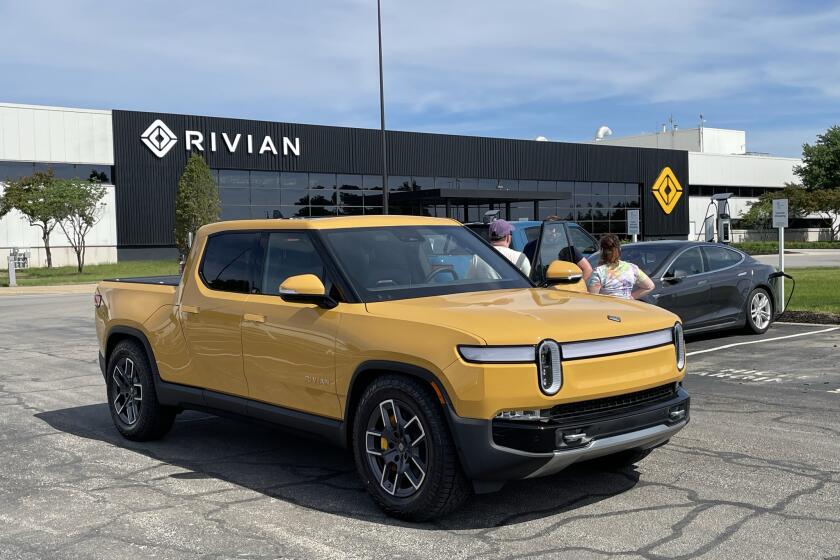LGB Chugs Softly and Carries a Big Track : W. German Model Train Maker Is Bringing Its Success Story to San Diego
They go around and around, through miniature tunnels and past plastic forests, before pulling into tiny train stations where porters and passengers are perpetually frozen in anticipation.
This is the world of model trains, one in which an increasing number of mostly male Americans, from schoolboys to affluent middle-aged adults, are immersing themselves. After half a decade in which trains were supplanted by other toys such as slot cars, video games and remote-control airplanes as gadgets of choice, interest in toy trains is on the rebound.
Among the hottest model trains on the market is LGB, a large-scale, high-priced train made in West Germany that is so durable it can run in the back yard any time of the year. The company’s parent firm, E. P. Lehmann Patentwerk of Nuremberg, is setting up its U. S. sales, service and distribution center in San Diego.
LGB sells more than a train: It will supply the world to go along with it, in the form of bridges, houses, hills, even farmyards and other accessories.
Twenty years ago, LGB took a gamble when it introduced the first “G-scale” train, or one that is half again as large as the predominant “O-scale” trains made popular by Lionel. The O-scale trains, which run on tracks an inch and a quarter wide, and HO-scale trains, which run on tracks less than three-quarters of an inch wide, are what most boys have found under their Christmas trees over the years.
Despite prices that begin at nearly $300 for a three-car “starter set,” LGB sales have taken off over the past five years, growing at average annual rates of 20% to 30%, according to Wolfgang Richter, president of E. P. Lehmann Patentwerk.
Of LGB’s projected $50 million in worldwide sales this year, about 35% will come from U. S. buyers. And since 60% of those are rung up in California, Oregon and Washington hobby shops, LGB decided to locate its U. S. headquarters on the West Coast.
LGB is not the only toy manufacturer profiting from the new-found interest in “modeling.” After tough times in the early 1980s, caused partly by a misguided move of manufacturing to Tijuana and partly by the mismanagement of former parent company General Mills, Lionel now reports strong growth in sales.
Lionel, based in Mt. Clemens, Mich. and privately owned by real estate developer and “modeler” Richard Kughn, declined to disclose specific sales figures.
Also reporting stronger sales is Athearn Corp., the nation’s leading maker of HO-scale trains and employer of 100 at its headquarters and plant in Compton.
“It’s not only our business but the entire industry that is on the upswing,” said Adora Athearn. She is the wife of Athearn Corp. founder Irvin Athearn, who started the company in his mother’s garage 45 years ago. Athearn also declined to disclose specific sales figures.
The overall market for model trains probably exceeded $284 million last year, according to Russ Larson, editor of Model Railroader, a hobbyists’ magazine published in Milwaukee. The “hobby” portion of the market, geared to those who build elaborate, semi-permanent scale layouts, reached $184 million in 1987, up from $133 million five years ago, Larson said.
Sales of the less expensive ready-to-run toy train sets, the kind most often brought by Santa on Christmas, accounted for more than $100 million in sales last year, Larson estimated.
Another indication of the hobby’s increased popularity is the fact that the monthly circulation of Model Railroader, which claims to have 85% of all model train enthusiasts as its subscribers, has grown 8% over the past year to 196,530. (A study of its subscribers by the magazine revealed that 99% of all hobbyists are male. The average age of the modelers is 43, and most are relatively affluent.)
But LGB’s success stands out from the rest. From a virtually nil share of the market five years ago, LGB now has a 3.5% slice of the pie and is rapidly attracting imitators, Larson said.
“LGB is the founder of the G scale, which is the hottest item going in trains right now,” said Steve Shoe, executive secretary of the Model Railroad Industry Assn., a Denver-based trade group of 126 companies. “They have really been a big boon to the hobby because they brought in a whole new scale.”
Richter, the president, attributes the company’s success to the thick-walled plastic construction of the trains, which are historically-faithful versions of about 30 European and American trains and trolleys. The trains’ features--including whistles, smoke and lights--are remarkably true to life, and the brass tracks can withstand the stompings of an elephant.
E. P. Lehmann Patentwerk has a colorful past highlighted by a remarkable comeback from the vicissitudes of World War II and expropriation by the East German government.
Founded in 1881 in a suburb of Berlin by Ernst Paul Lehmann, the company was, by the turn of the century, a world-famous maker of small metal toys of ingenious design. Lehmann toys, which included gaily painted mechanical soldiers, cars, horses, birds, dogs, airplanes, beetles and motorcycles, have now become collectors’ items the world over.
Lehmann died in 1934, turning over control of the company to Johannes Richter, Wolfgang’s father. By that time, the company was struggling to survive the Depression. With the onset of World War II, the market for German-made toys all but dried up as the German war machine sucked up raw materials.
At war’s end, E. P. Lehmann managed to survive Soviet occupation and seemed headed for a comeback when the East German government expropriated the company in 1948.
Escaped to West Germany
Johannes Richter escaped to West Germany and set up E. P Lehmann Patentwerk in Nuremberg in 1951, starting from scratch. The scarcity of capital severely limited the company’s growth, and, as tin was replaced by plastic as the basic material for toys, copies of German ingenuity such as Lehmann’s by “knock-off” manufacturers in the Orient became all too easy.
It was against this discouraging backdrop that Wolfgang Richter and his brother Eberhard conceived the idea of making something radically different: the large-scale LGB train. And, despite initial fears that the train was too big and “space wasting” to suit modern life, non-stop sales growth of the LGB line over the last 20 years have proved the Richter brothers’ decision to be a shrewd one.
Wolfgang Richter, 60, has no intention of moving manufacturing from the Nuremberg plant, which now employs 300. But he sees the opening of the San Diego service and distribution center as a critical step in improving customer service. The plant here has reduced order-filling and repair time from an average of six weeks to two days, he said.



